but maybe this is what happens when you find yourself with a free afternoon, and you spend the first part of it looking at your dad's maps of where his bike has taken him in the past few months, and you know that this very moment, he and his brother are tearing around another mountain in a 4x4, and your mom tells you that she is gardening after she took a bike ride with your own brother, who is probably in the middle of a game or an anime episode now, if he is not rummaging through a kitchen cupboard for something to eat, and your other brother is probably getting ready to leave the apartment he showed you through Skype (maybe he now has that bike he said he was thinking of getting and is about to see if he and the Barcelona streets like each other), and you wonder whether your grandmother, sitting on her bed with the pink sheets in the lovely corner room with the view of those trees, still feels as fragile as a bird -- and if she'd still rather work on her crossword puzzles than finish her memoirs, because those are pages you'd like to hold one day, since any time you get to hold anyone you love is never enough.
28 September 2013
, And I'm going going going going to get you.
There are moments when you miss everyone so fiercely, you feel like stomping across forests, fields, rivers, and mountains just to show up at their kitchen door, see them at the counter fixing themselves an afternoon snack in the afternoon sunshine after a heavy rain, see them look up and smile at you and say, "Hey", and be happy to know that they are okay. To see them whole and healthy and about to eat something good and simple during a commercial break or while a file is downloading or while a game is saving, to know that they are in the middle of resting and enjoying themselves, even if you have not been around -- this is a weird need to have,
but maybe this is what happens when you find yourself with a free afternoon, and you spend the first part of it looking at your dad's maps of where his bike has taken him in the past few months, and you know that this very moment, he and his brother are tearing around another mountain in a 4x4, and your mom tells you that she is gardening after she took a bike ride with your own brother, who is probably in the middle of a game or an anime episode now, if he is not rummaging through a kitchen cupboard for something to eat, and your other brother is probably getting ready to leave the apartment he showed you through Skype (maybe he now has that bike he said he was thinking of getting and is about to see if he and the Barcelona streets like each other), and you wonder whether your grandmother, sitting on her bed with the pink sheets in the lovely corner room with the view of those trees, still feels as fragile as a bird -- and if she'd still rather work on her crossword puzzles than finish her memoirs, because those are pages you'd like to hold one day, since any time you get to hold anyone you love is never enough.
but maybe this is what happens when you find yourself with a free afternoon, and you spend the first part of it looking at your dad's maps of where his bike has taken him in the past few months, and you know that this very moment, he and his brother are tearing around another mountain in a 4x4, and your mom tells you that she is gardening after she took a bike ride with your own brother, who is probably in the middle of a game or an anime episode now, if he is not rummaging through a kitchen cupboard for something to eat, and your other brother is probably getting ready to leave the apartment he showed you through Skype (maybe he now has that bike he said he was thinking of getting and is about to see if he and the Barcelona streets like each other), and you wonder whether your grandmother, sitting on her bed with the pink sheets in the lovely corner room with the view of those trees, still feels as fragile as a bird -- and if she'd still rather work on her crossword puzzles than finish her memoirs, because those are pages you'd like to hold one day, since any time you get to hold anyone you love is never enough.
24 September 2013
thing-a-week 37 and 38: Vedic square experiments
For weeks 37 and 38, I experimented with the Vedic square.
I've always admired the geometric designs in Islamic art and architecture but figured that the math involved would be too complicated to learn. But, another recent Good Job Brain episode unlocked at least one secret for me by telling me about the Vedic square.
You can go ahead and read the brief Wikipedia article article about it, but the Vedic square is a 9x9 table that shows digital roots — the remainder of ((x * y) / 9) — instead of multiplication products:

If you draw lines connecting all the same digital roots in the square, you can already make some pretty neat shapes.
But you can also make simple, elegant designs if you take a whole row from the square, use the numbers in that row as measurements, and keep turning your paper at a certain angle until you get back to where you started.
Of course, those instructions might be difficult to understand without an example, but I'll get to those in a bit; please bear with my nerding out a little longer.
I tried to go all pen-and-paper for this, but it turns out that my protractor is inexact, so I put these black-and-white drawings together on a computer. Even then, I had trouble getting everything to line up just right, so I really have to hand it to the first artists who worked with these measurements by hand.
Whatever angle you choose, it looks like you'll get yourself nine possible shapes. I first went with all 90-degree angles, and all but one row led me to produce these swastika-like shapes. This is the one with sequence 1 (1, 2, 3, … , 9):

Sequence 5 (5, 1, 6, 2, 7, 3, 8, 4, 9):
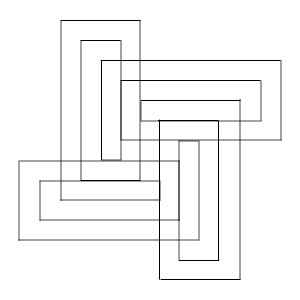
Sequence 7 (7, 5, 3, 1, 8, 6, 4, 2, 9):
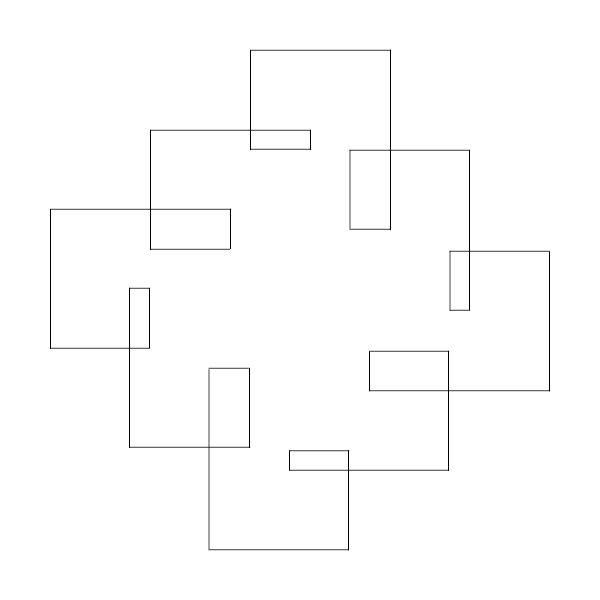
Sequences 2, 4, and 8 produced the same patterns, but in the reverse direction. Sequences 3 and 6, I felt, were too simple — four connected or overlapping rectangles in the same turning shape. The one row that didn't produce such a shape was row 9, which gave only a square.
At this point, I could appreciate for myself how the numbers of the Vedic square could be kind of cosmic, or why people might see them as holy, magical, or divine. The sequences are so simple, but if you follow them with one unbroken line, you create a shape that turns forever, and you always end up back where you began.
If you think this says something about the nature of life and the universe, then you'll probably find this either depressing or comforting.
I did two more designs by turning at a 45-degree angle. Here's sequence 2:
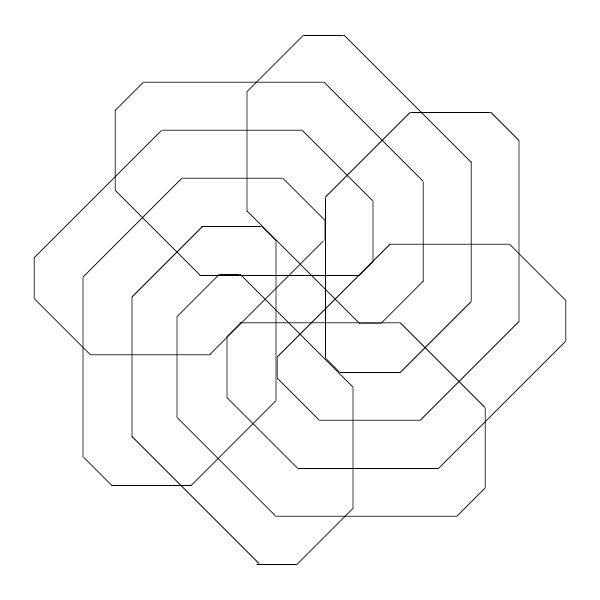
and sequence 5:

Of course, these things just beg to be colored, so I also printed out this last one and used it as a template for this:
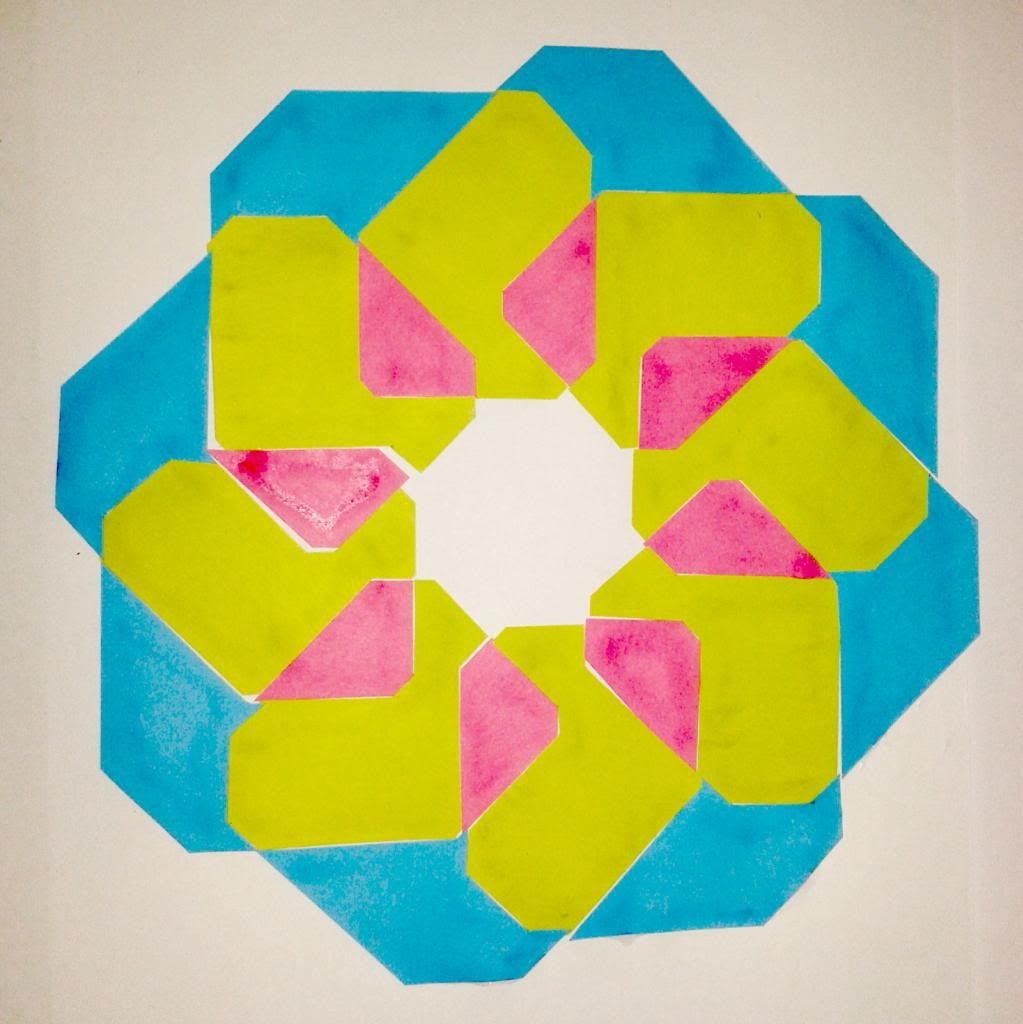
To my frustration, of course, doing this with paper wasn't as neat as it was on the computer. But, I like it enough to want to make more. And I still have other angles to try.
I've always admired the geometric designs in Islamic art and architecture but figured that the math involved would be too complicated to learn. But, another recent Good Job Brain episode unlocked at least one secret for me by telling me about the Vedic square.
You can go ahead and read the brief Wikipedia article article about it, but the Vedic square is a 9x9 table that shows digital roots — the remainder of ((x * y) / 9) — instead of multiplication products:

Thanks, Wikipedia.
If you draw lines connecting all the same digital roots in the square, you can already make some pretty neat shapes.
But you can also make simple, elegant designs if you take a whole row from the square, use the numbers in that row as measurements, and keep turning your paper at a certain angle until you get back to where you started.
Of course, those instructions might be difficult to understand without an example, but I'll get to those in a bit; please bear with my nerding out a little longer.
I tried to go all pen-and-paper for this, but it turns out that my protractor is inexact, so I put these black-and-white drawings together on a computer. Even then, I had trouble getting everything to line up just right, so I really have to hand it to the first artists who worked with these measurements by hand.
Whatever angle you choose, it looks like you'll get yourself nine possible shapes. I first went with all 90-degree angles, and all but one row led me to produce these swastika-like shapes. This is the one with sequence 1 (1, 2, 3, … , 9):

Sequence 5 (5, 1, 6, 2, 7, 3, 8, 4, 9):

Sequence 7 (7, 5, 3, 1, 8, 6, 4, 2, 9):

Sequences 2, 4, and 8 produced the same patterns, but in the reverse direction. Sequences 3 and 6, I felt, were too simple — four connected or overlapping rectangles in the same turning shape. The one row that didn't produce such a shape was row 9, which gave only a square.
At this point, I could appreciate for myself how the numbers of the Vedic square could be kind of cosmic, or why people might see them as holy, magical, or divine. The sequences are so simple, but if you follow them with one unbroken line, you create a shape that turns forever, and you always end up back where you began.
If you think this says something about the nature of life and the universe, then you'll probably find this either depressing or comforting.
I did two more designs by turning at a 45-degree angle. Here's sequence 2:

and sequence 5:

Of course, these things just beg to be colored, so I also printed out this last one and used it as a template for this:

To my frustration, of course, doing this with paper wasn't as neat as it was on the computer. But, I like it enough to want to make more. And I still have other angles to try.
18 September 2013
Letter No. 26
I’ve been thinking a lot about how alone we all really are. It’s something I’ve believed for a long while, but the feeling of loneliness that usually comes with thoughts like, We really are alone, has been heightened in the past month or so.
My brother Mikko is now in Spain to study, and that makes me, once again, the only member of my immediate family living in Manila. Even though we went to the same college and lived in adjacent dorms for a year, I never really made an effort to see or talk to him. Today, I wish I had, but I guess I was too consumed with senior year, then the struggle of figuring myself out and the challenge of the first attempt at a grown-up relationship.
When I think back now to those years of tears, I wonder, Why didn’t I just head north then to see Mikko? If I missed my family so much, why didn’t I seek him, my own brother, out?
I guess I thought he wouldn’t understand. I was the older sibling; I was supposed to know what I was doing. So I was surprised to find, after he moved to Makati and we started meeting for church every Sunday, that he could actually be a good influence on me.
I put something like this in the letter I gave him shortly before he left: Being around him helped to ground me. I'd spent the past couple of years alone, making decisions about the kind of person I wanted to be. Mikko's presence allowed me to check those decisions and that person against my family's attitudes and expectations. He didn't ask me these questions; just hanging out with him, walking around, and chatting about his own post-college adventures led me to ask myself: Am I really okay with how different I'm becoming? Am I being good; am I a good person?
I only saw Mikko once a week, but the clarity I got from those Sundays was such a great addition to my life. I decided that I wanted to elicit with my life the kind of pride that I already felt for my younger brother.
(And when it comes down to it, having family around helped me deal with how I felt after that first grown-up attempt at a relationship crumbled like a soggy cookie.)
Now, I'm on my own again.
The thing now is, for all I've learned about my brother, and for all the time I've spent with Cris, I can't help thinking that you can't really know somebody 100%. There's always something about yourself that feels like something known by you and you alone — you are alone in your knowledge.
For all I know about his dreams and his quirks, I know that there's still stuff going on in Mikko's head that I will probably never see, just like there's stuff going on in my head that I wonder if anybody else can see. When I'm in the car with Cris and we are quiet, or when he's watching TV while I'm playing a computer game, I feel as though the hands of my brain are trying to reach into his skull and his chest to try and get a hold on some of the mysteries waiting in there.
When I peel away layers and layers of my own identity — childhood memories, sense of humor, favorite colors, love of pizza and sashimi, family ties, anxiety upon anxiety tied with a bow of anxiety, scars self-inflicted and not, my oldest friends, grammar, languages, left-handedness — and see what's left there, staring back at me, I wonder if anyone else can see that, especially if I can't describe it to them anymore. So it makes me wonder if I see other people the way they'd like to be seen — if I ever can or will.
And even if I must accept that I'll never see another person 100%, is there a certain percentage of them I should be able to see, to be able to say that I know them? Why is it that, for all the lunches, blankets, hopes, and fears I've shared, I still feel like I can't be seen 100%?
Or should it be enough that, despite how little or much they do see, the people I love make me feel that it's okay to be 100% myself? Is it better to be content to give and receive that kind of compassion than to keep picking at all the layers in the hopes of finding whatever's really underneath?
As an early birthday present to myself, I bought a copy of The Sims 3. I know the game came out years ago, but I haven't had the right computer for it until now — and it's not even my computer; Cris just lets me use his every now and then.
I find the game eerily realistic in that the Sims claim to have good relationships with one another yet spend nearly all their time on their own pursuits. The family founders had a whirlwind romance and then barely saw each other after they got married and had kids, yet whenever one entered the room, the other's mood would rise. The eldest child is grumpy, neurotic, dislikes children, and spends most of her time writing or jogging, but she seems to enjoy family dinners and isn't above changing a niece or nephew's diaper if necessary. The son-in-law knew his mother-in-law for only a Sim week or so, but he bawled like the rest of them when she passed away. Should I aspire to be more like the people I've made, happy to simply be with each other, even if they don't seem to actually know each other?
My brother Mikko is now in Spain to study, and that makes me, once again, the only member of my immediate family living in Manila. Even though we went to the same college and lived in adjacent dorms for a year, I never really made an effort to see or talk to him. Today, I wish I had, but I guess I was too consumed with senior year, then the struggle of figuring myself out and the challenge of the first attempt at a grown-up relationship.
When I think back now to those years of tears, I wonder, Why didn’t I just head north then to see Mikko? If I missed my family so much, why didn’t I seek him, my own brother, out?
I guess I thought he wouldn’t understand. I was the older sibling; I was supposed to know what I was doing. So I was surprised to find, after he moved to Makati and we started meeting for church every Sunday, that he could actually be a good influence on me.
I put something like this in the letter I gave him shortly before he left: Being around him helped to ground me. I'd spent the past couple of years alone, making decisions about the kind of person I wanted to be. Mikko's presence allowed me to check those decisions and that person against my family's attitudes and expectations. He didn't ask me these questions; just hanging out with him, walking around, and chatting about his own post-college adventures led me to ask myself: Am I really okay with how different I'm becoming? Am I being good; am I a good person?
I only saw Mikko once a week, but the clarity I got from those Sundays was such a great addition to my life. I decided that I wanted to elicit with my life the kind of pride that I already felt for my younger brother.
(And when it comes down to it, having family around helped me deal with how I felt after that first grown-up attempt at a relationship crumbled like a soggy cookie.)
Now, I'm on my own again.
The thing now is, for all I've learned about my brother, and for all the time I've spent with Cris, I can't help thinking that you can't really know somebody 100%. There's always something about yourself that feels like something known by you and you alone — you are alone in your knowledge.
For all I know about his dreams and his quirks, I know that there's still stuff going on in Mikko's head that I will probably never see, just like there's stuff going on in my head that I wonder if anybody else can see. When I'm in the car with Cris and we are quiet, or when he's watching TV while I'm playing a computer game, I feel as though the hands of my brain are trying to reach into his skull and his chest to try and get a hold on some of the mysteries waiting in there.
When I peel away layers and layers of my own identity — childhood memories, sense of humor, favorite colors, love of pizza and sashimi, family ties, anxiety upon anxiety tied with a bow of anxiety, scars self-inflicted and not, my oldest friends, grammar, languages, left-handedness — and see what's left there, staring back at me, I wonder if anyone else can see that, especially if I can't describe it to them anymore. So it makes me wonder if I see other people the way they'd like to be seen — if I ever can or will.
And even if I must accept that I'll never see another person 100%, is there a certain percentage of them I should be able to see, to be able to say that I know them? Why is it that, for all the lunches, blankets, hopes, and fears I've shared, I still feel like I can't be seen 100%?
Or should it be enough that, despite how little or much they do see, the people I love make me feel that it's okay to be 100% myself? Is it better to be content to give and receive that kind of compassion than to keep picking at all the layers in the hopes of finding whatever's really underneath?
As an early birthday present to myself, I bought a copy of The Sims 3. I know the game came out years ago, but I haven't had the right computer for it until now — and it's not even my computer; Cris just lets me use his every now and then.
I find the game eerily realistic in that the Sims claim to have good relationships with one another yet spend nearly all their time on their own pursuits. The family founders had a whirlwind romance and then barely saw each other after they got married and had kids, yet whenever one entered the room, the other's mood would rise. The eldest child is grumpy, neurotic, dislikes children, and spends most of her time writing or jogging, but she seems to enjoy family dinners and isn't above changing a niece or nephew's diaper if necessary. The son-in-law knew his mother-in-law for only a Sim week or so, but he bawled like the rest of them when she passed away. Should I aspire to be more like the people I've made, happy to simply be with each other, even if they don't seem to actually know each other?
06 September 2013
thing-a-week 33-36: a month of kirigami drills
I've been itching to make more kirigami models but haven't had any good ideas lately, so I decided to do some exercises with stairs. I still haven't come up with any new ideas for models after this, but I can say I've gotten faster at drafting models to cut. The exercises have also helped me see potential technical missteps I might make if and when I do have something new to work on.
And, of course, kirigami is always therapeutic.
33: I came up with this after staring at some Masahiro Chatani models on the Internet. It was supposed to be more complex, but I was off at the start by a few centimeters, and that affected how much room I had for more layers.
In general, I work in centimeters and half-centimeters; any smaller can get hard to fold.
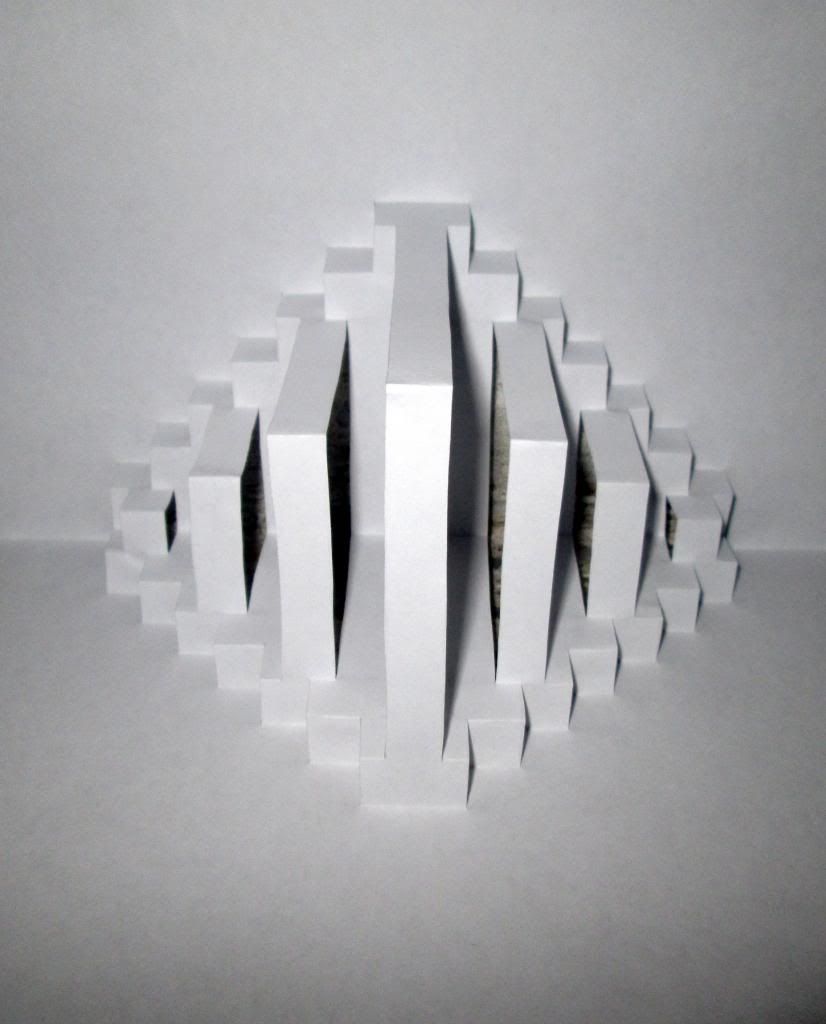
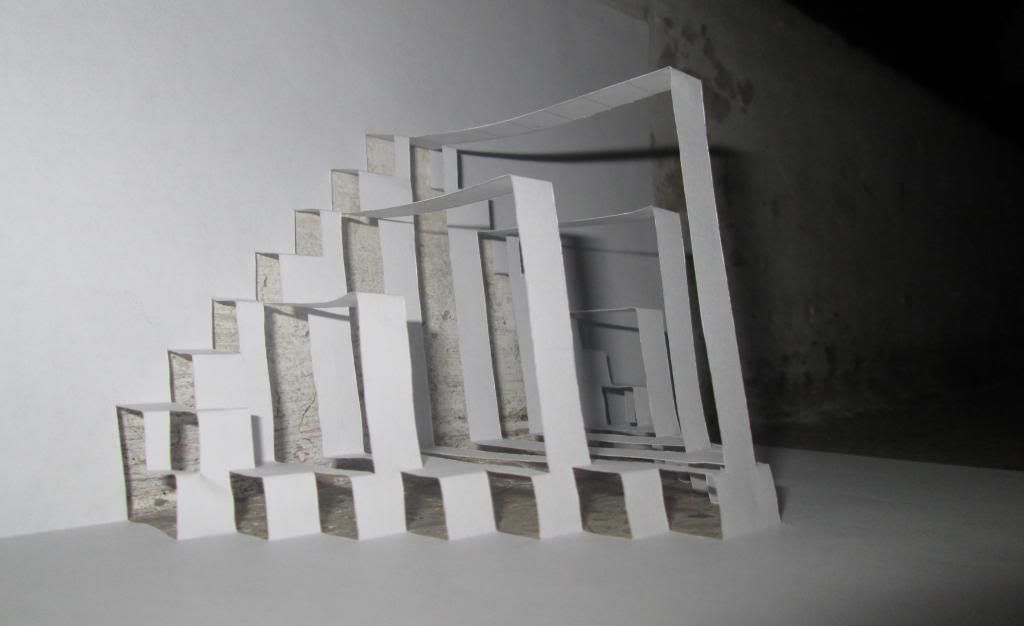
34: This one was more messing around than an exercise, but the nesting arch trick here helped me figure something out for a card/letter I made for my brother later that week. (I guess I did have a new idea. But since it's personal, I'm not going to post photos of it here.)
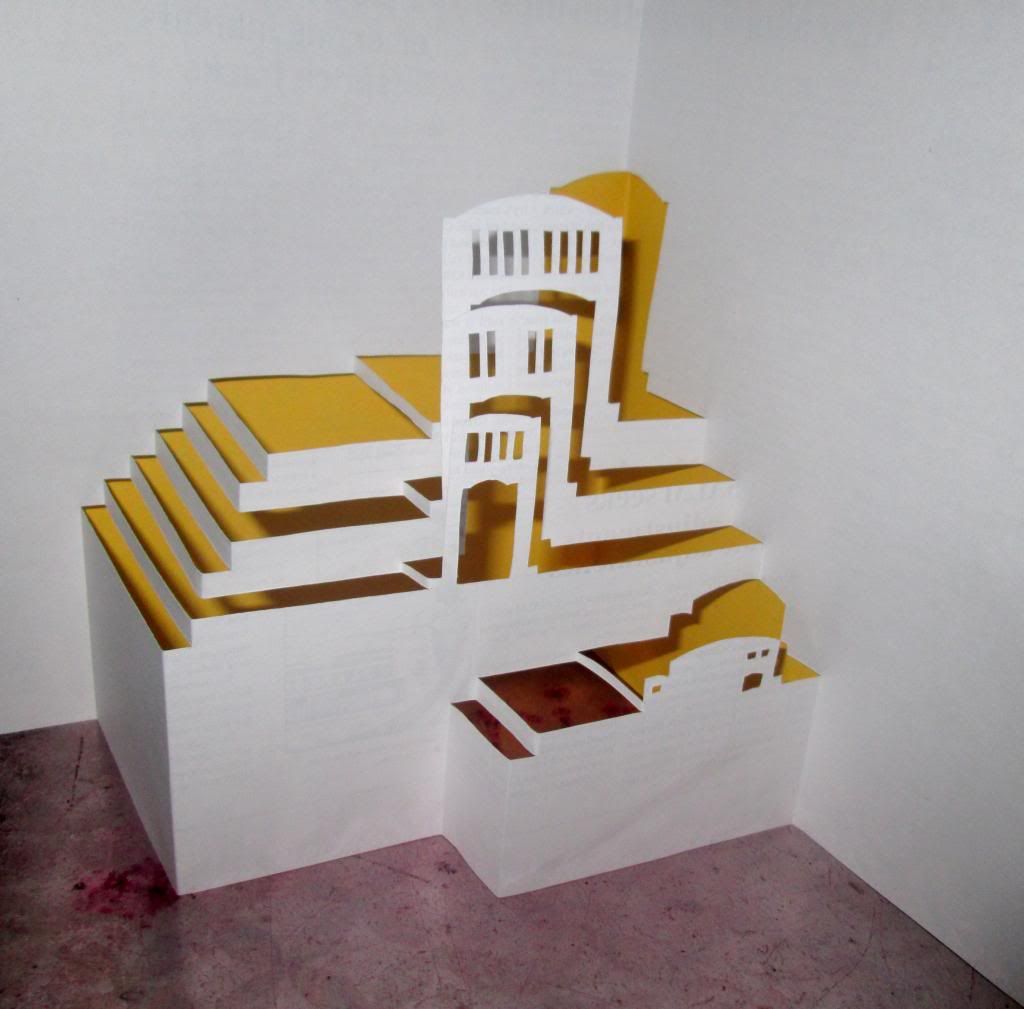
35: This was another exercise I set for myself after looking at Masahiro Chatani models.
Folding adjacent stairs like these needs some care; you can see diagonal bumps where the staircase in front pulled on the one in the back.
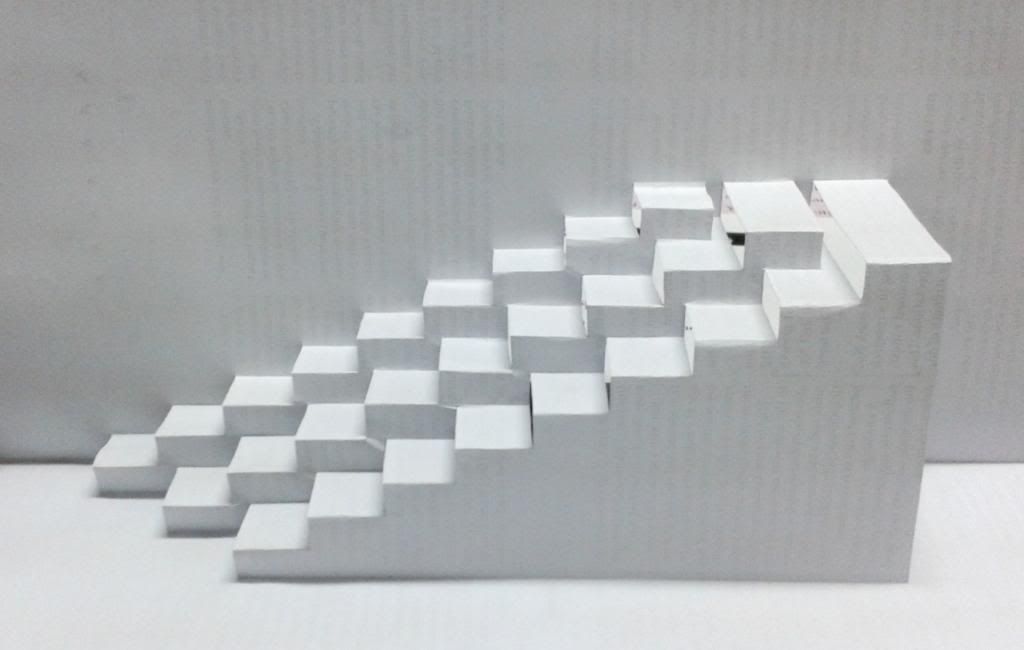
36: I saw some photos of Chand Baori, which appeared in that really gorgeous Tarsem Singh movie, The Fall, as well as in The Dark Knight Rises. Yes, yes, more stairs.
The difficulty I had with this model was measuring the base. I wanted stairs all the way to the base, but again, I had some measurement problems. You can also see some wrong creases at the base due to those problems.
While it looks nice, I'm not fond of horizontal models that go so far out from the spine; if the paper is soft or becomes soft (e.g. from moisture or from someone sitting on it by accident), it starts to collapse in on itself.

And, of course, kirigami is always therapeutic.
33: I came up with this after staring at some Masahiro Chatani models on the Internet. It was supposed to be more complex, but I was off at the start by a few centimeters, and that affected how much room I had for more layers.
In general, I work in centimeters and half-centimeters; any smaller can get hard to fold.


34: This one was more messing around than an exercise, but the nesting arch trick here helped me figure something out for a card/letter I made for my brother later that week. (I guess I did have a new idea. But since it's personal, I'm not going to post photos of it here.)

35: This was another exercise I set for myself after looking at Masahiro Chatani models.
Folding adjacent stairs like these needs some care; you can see diagonal bumps where the staircase in front pulled on the one in the back.

36: I saw some photos of Chand Baori, which appeared in that really gorgeous Tarsem Singh movie, The Fall, as well as in The Dark Knight Rises. Yes, yes, more stairs.
The difficulty I had with this model was measuring the base. I wanted stairs all the way to the base, but again, I had some measurement problems. You can also see some wrong creases at the base due to those problems.
While it looks nice, I'm not fond of horizontal models that go so far out from the spine; if the paper is soft or becomes soft (e.g. from moisture or from someone sitting on it by accident), it starts to collapse in on itself.

Subscribe to:
Comments (Atom)